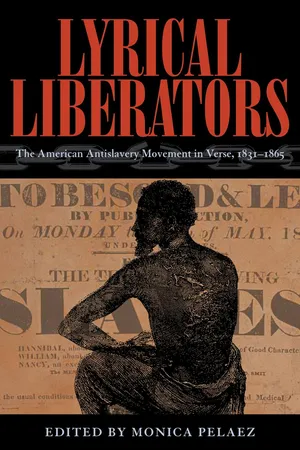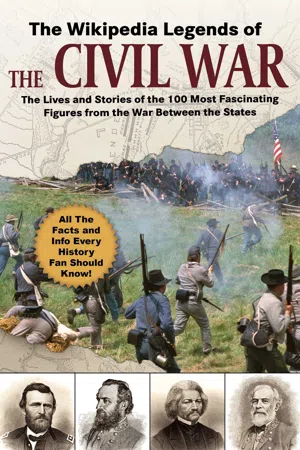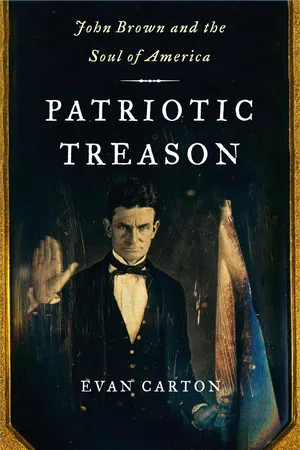History
John Brown's Raid
John Brown's Raid was a failed attempt by abolitionist John Brown to initiate a slave rebellion by seizing the federal arsenal at Harpers Ferry, Virginia, in 1859. Brown and his followers were quickly captured by U.S. Marines, and Brown was subsequently tried and executed for treason. The raid heightened tensions between the North and South and is considered a precursor to the American Civil War.
Written by Perlego with AI-assistance
Related key terms
6 Key excerpts on "John Brown's Raid"
- eBook - ePub
Lyrical Liberators
The American Antislavery Movement in Verse, 1831–1865
- Monica Pelaez(Author)
- 2018(Publication Date)
- Ohio University Press(Publisher)
5 JOHN BROWN AND THE RAID ON HARPERS FERRYJOHN BROWN EARNED a name for himself as an abolitionist crusader as early as 1855, when he proved his zealous commitment to the cause by going so far as to kill proslavery agitators during the border conflicts in the Kansas territory where he had settled with his sons (see chapter 4 ). Although he crossed paths with William Lloyd Garrison and his supporters on several occasions, he was notably overheard to complain at the New England Anti-Slavery Convention in 1859 that “these men are all talk; what is needed is action—action!”1 Matching his deeds to his words, on October 16, 1859, he led a raid on Harpers Ferry, Virginia, in the hopes of inciting a slave uprising that would be armed with weapons seized from the town’s arsenal.2 Although his group succeeded in seizing several buildings and hostages, no slaves ultimately rallied to their cause, and the raiders were captured the following day by federal troops under the command of Colonel Robert E. Lee. Brown was subsequently tried for treason against the Commonwealth of Virginia, convicted, and hung. In the final speech he delivered during his trial he exonerated himself by arguing that his intention to free the slaves was in accordance with the New Testament, “that teaches me that all things whatsoever I would that men should do to me, I should do even so to them. It teaches me, further, to remember them that are in bonds, as bound with them.”3Although public opinion initially judged Brown’s actions as misguided, views shifted during the course of his trial and he increasingly came to be depicted as a martyr for the cause. Paul Finkelman has shown that Brown’s martyrdom “was shaped by the apparent unfairness of his trial, his letters from jail, his stoic behavior at the gallows, and the efforts of antislavery activists to exploit his execution for the greater cause.”4 Brown himself recognized how valuable his death would be to the movement in a letter confessing to his brother, “I am worth inconceivably more to hang than for any other purpose,” while Garrison also acknowledged that “John Brown executed will do more for our good cause, incomparably, than John Brown pardoned.”5 Indeed, on the day of his execution numerous meetings were held across the North to proclaim his martyrdom and condemn slavery through speeches and resolutions. The American Anti-Slavery Society notably dedicated its annual report of 1859 to “the memory of the noble hero-martyr.”6 He was cast in this role as well by leading authors of the time like Ralph Waldo Emerson, who referred to Brown as a “new saint” who “will make the gallows glorious like the Cross,” a sentiment that was echoed by others ranging from Herman Melville to Henry David Thoreau.7 The black activist Frances Ellen Watkins Harper had already anticipated the significance of his sacrifice when she wrote to Brown in prison, “if Universal Freedom is ever to be the dominant power of the land, your bodies may be only her first stepping stones to dominion.”8 - eBook - ePub
- Frederick Douglass, James Daley(Authors)
- 2013(Publication Date)
- Dover Publications(Publisher)
John Brown (1881)John Brown gained notoriety throughout the 1850s as a revolutionary abolitionist who advocated armed rebellion as a means for ending the practice of slavery in the United States. He was executed shortly after leading 18 men on a raid of the Harpers Ferry Armory in 1859. In the following speech, delivered on May 30, 1881 at the Fourteenth Anniversary of Storer College, Douglass discusses the lasting impact of John Brown’s life on the history of Slavery in America.Not to fan the flame of sectional animosity now happily in the process of rapid and I hope permanent extinction, not to revive and keep alive a sense of shame and remorse for a great national crime, which has brought its own punishment, in loss of treasure, tears and blood, not to recount the long list of wrongs, inflicted on my race during more than two hundred years of merciless bondage; nor yet to draw, from the labyrinths of far-off centuries, incidents and achievements wherewith to rouse your passions, and enkindle your enthusiasm, but to pay a just debt long due, to vindicate in some degree a great historical character, of our own time and country, one with whom I was myself well acquainted, and whose friendship and confidence it was my good fortune to share, and to give you such recollections, impressions and facts, as I can, of a grand, brave and good old man, and especially to promote a better understanding of the raid upon Harper’s Ferry of which he was the chief, is the object of this address.In all the thirty years’ conflict with slavery, if we except the late tremendous war, there is no subject which in its interest and importance will be remembered longer, or will form a more thrilling chapter in American history than this strange, wild, bloody and mournful drama. The story of it is still fresh in the minds of many who now hear me, but for the sake of those who may have forgotten its details, and in order to have our subject in its entire range more fully and clearly before us at the outset, I will briefly state the facts in that extraordinary transaction. - eBook - ePub
The Wikipedia Legends of the Civil War
The Incredible Stories of the 75 Most Fascinating Figures from the War Between the States
- (Author)
- 2020(Publication Date)
- Skyhorse(Publisher)
John Brown
Photo by Augustus Washington, circa 1846–1847John Brown (May 9, 1800–December 2, 1859) was an American abolitionist. Brown advocated the use of armed insurrection to overthrow the institution of slavery in the United States. He first gained national attention when he led small groups of volunteers during the Bleeding Kansas crisis of 1856. He was dissatisfied with the pacifism of the organized abolitionist movement: “These men are all talk. What we need is action—action!” In May 1856, Brown and his supporters killed five supporters of slavery in the Pottawatomie massacre, which responded to the sacking of Lawrence by pro-slavery forces. Brown then commanded anti-slavery forces at the Battle of Black Jack (June 2) and the Battle of Osawatomie (August 30, 1856).In October 1859, Brown led a raid on the federal armory at Harpers Ferry, Virginia (today West Virginia), intending to start a slave liberation movement that would spread south through the mountainous regions of Virginia and North Carolina; there was a draft constitution for the state he hoped to establish. He seized the armory, but seven people were killed, and ten or more were injured. He intended to arm slaves with weapons from the arsenal, but only a small number of local slaves joined his revolt. Within 36 hours, those of Brown’s men who had not fled were killed or captured by local farmers, militiamen, and US Marines, the latter led by Robert E. Lee. He was hastily tried for treason against the Commonwealth of Virginia, the murder of five men (including three blacks), and inciting a slave insurrection; he was found guilty on all counts and was hanged. He was the first person convicted of treason in the history of the country.[1]:179Historians agree that the Harpers Ferry raid and Brown’s trial, both covered extensively by the national press, escalated tensions that led to the South’s secession a year later and the American Civil War. Brown’s raid captured the nation’s attention; Southerners feared that it was just the first of many Northern plots to cause a slave rebellion that might endanger their lives, while Republicans dismissed the notion and claimed that they would not interfere with slavery in the South. “John Brown’s Body” was a popular Union marching song that portrayed him as a martyr. - eBook - ePub
Patriotic Treason
John Brown and the Soul of America
- Evan Carton(Author)
- 2006(Publication Date)
- Atria Books(Publisher)
In a letter to a friend from prison, John Brown wrote: “Before I began my work at Harpers Ferry, I felt assured that in the worst event it would certainly pay. I often expressed that belief; and I can see no possible cause to alter my mind.” Brown’s work began to pay immediately by forcing to the surface the moral and psychological fissures in the foundation of southern society. Far from “harmless,” the raid had activated explosive contradictions that shattered the political status quo, which had depended on their dormancy and suppression. Chief among these was the contradiction between the south’s asserted pride in its benign and paternalistic tradition of labor and social relations between the races—a far more humane and civilized system, it was argued, than the impersonal “wage slavery” of the north—and its unspoken terror of murderous revolt by its black millions.In the raid’s aftermath, Wise and others struggled to prop up the pride and restore the complacency about black allegiance to their masters by trumpeting the voluntary return of Allstadt’s and Washington’s slaves to their homes. Virginia’s slaves, they insisted, had given Brown no support. On the other hand, the hysterical eyewitness reports by railroad employees and passengers that converted five or six armed black men into five or six hundred, and the immediate and universal credence that those reports received, belied all assertions of confidence in the contentment of the servant class, let alone in “the impregnable safety of the South.” Either the people whose self-emancipation was capable of producing such extravagant fear among white southerners were indeed subhuman beasts controllable by relentless force alone, or the south was, as Brown charged, “guilty of a great wrong against God and humanity,” and its vision of murderous black revolt was the specter of self-punishment that its afflicted conscience placed before its eyes.The Harpers Ferry raid proved effective not in any military or emancipatory goals that it achieved, but in the experience that it triggered. It was this experience that was registered by the southern journals that the New York Times - eBook - ePub
Historic Adventures
Tales From American History
- (Author)
- 2013(Publication Date)
- The Floating Press(Publisher)
In the heart of the Alleghanies, and almost midway between Maine and Florida, is a great natural gateway in the mountains. Here the Potomac and the Shenandoah Rivers meet, and seem to force their way through the natural barrier. This pass is Harper's Ferry, and in 1859 it was the seat of a United States arsenal. To the south was a country filled with slaves, who looked to Harper's Ferry as the highroad to freedom. Not far from the arsenal rose the Blue Ridge Mountains, the heights of which commanded the pass. It was John Brown's plan to lead men from the Maryland side of the Potomac River to attack the arsenal, and when it was captured to carry arms and ammunition across the Shenandoah to Loudoun Heights in the Blue Ridge, and hide there. From here his band could make raids to the south, freeing slaves, and shielding them from their masters, while using the mountains for a shelter.There were many other men in the United States bent on destroying slavery, but few so impulsive as John Brown. His plan was rash in the extreme, and even its success would have profited only a few slaves. But Brown was a born crusader. The men who followed him were all impulsive, and many of them were already trained in the rude ways of frontier life. They knew what he had done in Kansas, and were ready to fight on his side anywhere else. They had a real reverence for John Brown. The tall man with the long, almost white hair, keen eyes, and flowing beard was no ordinary leader. He had the power to convince men that his cause was just, and to hold them in his service afterward.In June, 1859, John Brown, with two of his sons, and two friends, started south. He rented a farm about five miles from Harper's Ferry, in a quiet, out-of-the-way place. There were several cabins in the neighborhood, and as his followers gradually joined him, they occupied these shelters. A daughter kept house for him during the summer. The men farmed in the daytime, and planned their conspiracy at night. The leader did everything he could to win the friendship of his neighbors. He had some knowledge of medicine, and attended all who were sick. Frequently he preached in the little Dunker chapel near by. He was always ready to share his food or give the shelter of his roof to any travelers. Slowly he collected guns and ammunition, and late in September sent his daughter north, and arranged to make his attack. At first some of the other men objected to his plans. One or two did not approve of his seizing the government arsenal, and thought they should simply make a raid into Virginia as the slave-state men had formerly carried war into Kansas. Their leader, however, was determined, and nothing could turn him. Already he feared lest some suspicion of his purpose might have spread, and was eager to make his start. He set Sunday night, October 16th, as the time for the raid. That morning he called his men together and read to them from the Bible. In the afternoon he gave them final instructions, and added: "And now, gentlemen, let me impress this one thing upon your minds. You all know how dear life is to you, and how dear life is to your friends. And in remembering that, consider that the lives of others are as dear to them as yours are to you. Do not, therefore, take the life of any one, if you can possibly avoid it; but if it is necessary to take life in order to save your own, then make sure work of it." - eBook - ePub
Nothing but the Truth
Why Trial Lawyers Don't, Can't, and Shouldn't Have to Tell the Whole Truth
- Steven Lubet(Author)
- 2001(Publication Date)
- NYU Press(Publisher)
Brown’s aim was not only to defeat the charge of murder, which he hoped to do by demonstrating that he had shown compassion rather than malice toward his captives, and by extension that he had no intention to murder anyone. But that goal was subordinate to his larger purpose, which was to enhance the image of his entire endeavor by emphasizing its humanitarian, rather than military, objectives. It would have been nearly impossible to engender sympathy in the North for a bloody invasion of peaceful Harpers Ferry (hence the need for a lawyer who was not an ultra-abolitionist). A much stronger case, however, could be made for a tempered mission to rescue slaves in which no property was to be damaged and “no unarmed person should be injured under any circumstances whatsoever.” And there began the reinvention of John Brown.Of course, the claim was false. Brown had no particular respect for southern property or for the lives of slave owners. He had proven as much by the killings in Kansas and Missouri. In fact, he believed that he was completely justified in taking lives, as he had explained early in the raid to his second hostage, the watchman Daniel Whelan: “I came here from Kansas, and this is a slave state; I want to free all the negroes in this State; I have possession now of the United States armory, and if the citizens interfere with me I must only burn the town and have blood.”Truthfully or otherwise, Brown’s case could best be presented to the world with the assistance of cooperative counsel. While the trial began with Botts and Green at the defense table, they were eventually dismissed.One northern lawyer did arrive near the beginning of Brown’s trial. In strictly professional terms, his conduct was far more questionable than anything done by Botts and Green.George H. Hoyt was a neophyte lawyer from Athol, Massachusetts. Only twenty-one years old, he appeared even younger. Within days of the Harpers Ferry raid, Hoyt was retained by John Le Barnes, a Boston abolitionist, and sent directly to Charlestown, ostensibly to assist in Brown’s defense.In reality, however, Hoyt was sent not as a lawyer but as an advance scout with directions to begin planning an escape attempt. Hoyt was instructed to send Le Barnes
Learn about this page
Index pages curate the most relevant extracts from our library of academic textbooks. They’ve been created using an in-house natural language model (NLM), each adding context and meaning to key research topics.





